Mauryan Empire › Bhagavad Gita » Ancient origins
Articles and Definitions › Contents
- Mauryan Empire › Antique Origins
- Bhagavad Gita › Antique Origins
Ancient civilizations › Historical and archaeological sites
Mauryan Empire › Antique Origins
Definition and Origins
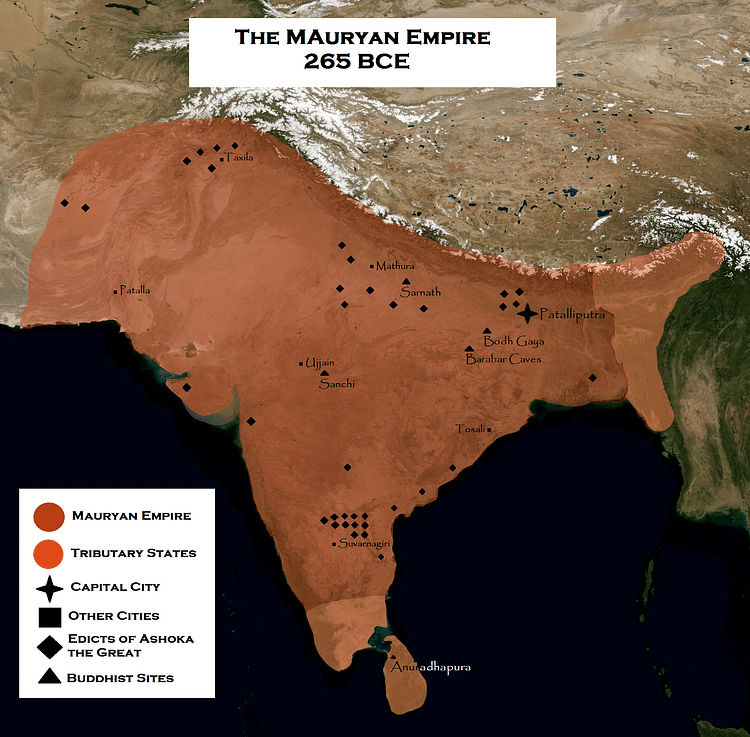
The Mauryan Empire (322 BCE - 185 BCE) supplanted the earlier Magadha Kingdom to assume power over large tracts of eastern and northern India. At its height, the empire stretched over parts of modern Iran and almost the entire Indian subcontinent, barring only the southern peninsular tip. The empire came into being when Chandragupta Maurya stepped into the vacuum created by Alexander of Macedon 's departure from the western borders of India. Chandragupta subjugated the border states, recruited an army, marched upon the Magadha kingdom, killed its tyrannical king who was despised by the populace, and ascended the throne. He thus founded the Mauryan dynasty. In his rise to power, he was aided and counselled by his chief minister Kautilya (also known as Chanakya ), who wrote the Arthashastra, a compendium of kingship and governance.
CONSOLIDATION OF POWER
Chandragupta embarked upon an aggressive expansion policy. Seleucos I Nicator, who was Alexander's satrap for the eastern Macedonian conquests, was defeated and had to cede the entire territory under him to Chandragupta, along with a daughter and considerable money. He also sent Megasthenes, who wrote the Indica, to the Mauryan court as the Greekambassador.
Chandragupta used marriage alliances, diplomacy, trickery, and war to extend his kingdom. Under him, the Mauryan empire stretched from eastern Iran to the western borders of the Burmese hills, and from the Himalayan tribal kingdom to the southern plateaus of peninsular India. After ruling for about 25 years, Chandragupta abdicated in favour of his son, Bindusara, and became a Jain monk.
Bindusara maintained his father's large dominions efficiently and extended the southern borders to cover the peninsular plateau of India. When he died, his son Ashoka seized the throne after a fratricidal succession dispute. The empire that Ashoka inherited was large, but a small kingdom on the east coast, Kalinga, was outside its pale. Ashoka decided to conquerit. The war that ensued was bloody and long. Kalinga resisted to the last man but fell. After Kalinga, Ashoka did not attack any kingdom but proceeded on a mission of peace. He erected several pillars throughout his kingdom, exhorting people to give up violence and live in harmony with each other and with nature. He actively patronised Buddhism, built several stupas and repaired older ones, and sent evangelical missions abroad, two of which comprised his own son and daughter.
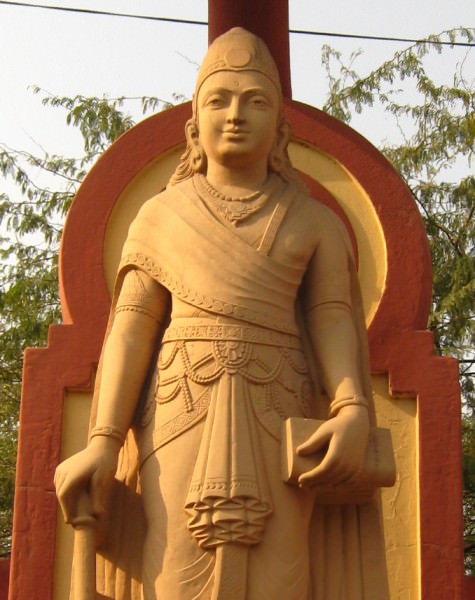
Statue of Mauryan Emperor Chandragupta
...various animals were declared to be protected — parrots, mainas, aruna, ruddy geese, wild ducks, nandimukhas, gelatas, bats, queen ants, terrapins, boneless fish, vedareyaka, gangapuputaka, sankiya fish, tortoises, porcupines, squirrels, deer, bulls, okapinda, wild asses, wild pigeons, domestic pigeons and all four-footed creatures that are neither useful nor edible. Those nanny goats, ewes and sows which are with young or giving milk to their young are protected, and so are young ones less than six months old. Cocks are not to be caponized, husks hiding living beings are not to be burnt and forests are not to be burnt either without reason or to kill creatures. One animal is not to be fed to another. On the three Caturmasis, the three days of Tisa and during the fourteenth and fifteenth of the Uposatha, fish are protected and not to be sold. During these days animals are not to be killed in the elephant reserves or the fish reserves either. On the eighth of every fortnight, on the fourteenth and fifteenth, on Tisa, Punarvasu, the three Caturmasis and other auspicious days, bulls are not to be castrated, billy goats, rams, boars and other animals that are usually castrated are not to be. On Tisa, Punarvasu, Caturmasis and the fortnight of Caturmasis, horses and bullocks are not be branded.
(Pillar edict)
The successor's of Ashoka were not strong enough to hold the empire together. It started disintegrating bit by bit, and in 185 BCE, almost 150 years after Chandragupta had overthrown the Magadha king, the last Mauryan ruler was assassinated by his commander-in-chief while inspecting his troops.
ECONOMY
Trade and enterprise were public-private affairs: the state could own and engage in business activities just like ordinary citizens could. The royal revenue was drawn from taxes (and war booty). Additionally, the king owned timber land, forest land, hunting groves, and manufacturing facilities, and their surplus was sold off. The state had monopoly over coinage, mining, salt production, arms manufacture, and boat building.
THE STATE COULD OWN & ENGAGE IN BUSINESS ACTIVITIES JUST LIKE ORDINARY CITIZENS COULD.ADDITIONALLY, IT HAD A MONOPOLY OVER COINAGE, MINING, SALT PRODUCTION, ARMS MANUFACTURE, & BOAT BUILDING.
Farmers comprised the largest part of the population, and agriculture was taxed. Tradespeople were organised into guilds that held both executive and judicial authority and also functioned as banks. Craftspeople engaged in a particular industry tended to live together. Goods could not be sold at the place where they were produced; they had to be brought to specific markets.Tolls were collected for roads and river crossings; and goods sold within the kingdom were taxed, as were imports and exports.The state fixed the wholesale price of goods and inspected weights and measures. Barter was prevalent, as were gold, bronze, and copper coins. Money was lent on interest against promissory notes.
The main road that ran through the entire kingdom and connected it to the western Greek world was well maintained and well patrolled, with pillars and signposts marking the distances and the by-roads. Ships sailed down the Ganges and its tributaries, and to foreign shores such as Sri Lanka, China, and the African and Arabian harbours, and the state took care to destroy pirates.
ADMINISTRATION
The king was the head of the state and controlled the military, executive, judiciary, and legislature. He took advice from a council comprising the chief minister, the treasurer, the general, and other ministers. The kingdom was divided into provinces under governors, who were often royal princes. Provinces were further composed of towns and villages under their own district and village administrators. It was a large bureaucracy that the king employed. Like today, the rungs in the civil services were clearly defined, and those at the very top were far removed from the lower grades. For example, the ratio of a clerk's salary to the chief minister's has been estimated at 1:96. With such high levels of salary, we can assume that the higher officers were expected to carefully oversee the functioning of their departments.
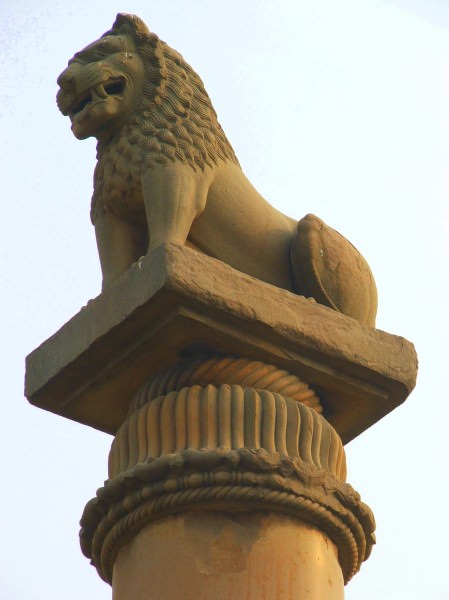
Ashoka's pillar
There were departments to govern, look after, and control almost every aspect of social life: industrial art, manufacturing facilities, general trade and commerce, foreigners, births and deaths, commercial taxes, land and irrigation, agriculture, forests, metal foundries, mines, roads, and public buildings. The high-ranking officers were expected to go on inspection tours to ensure that the bureaucracy was discharging its duties well.
He who causes loss of revenue eats up the king's wealth, he who produces double the [anticipated] revenue eats up the country, and he who spends all the revenue [without bringing any profit] eats up the labour of workmen.
(Arthashastra, 2.9.13, 15, 17)
The empire also had a large spy network and maintained a large standing army. The king's army was not really disbanded even after the third Mauryan king, Ashoka, gave up war. Next to the farmers, it was the soldiers who formed the bulk of the population. Soldiers were expected to only fight and were not required to render any other service to the king; when there was no war, they could amuse themselves in whatever manner that caught their fancy. There were separate departments for the infantry, cavalry, navy, chariots, elephants, and logistics. Soldiers not only drew their salary from the exchequer but were also provided with arms and equipment at the state's expense. We have descriptions of some of the arms that these soldiers carried: foot soldiers carried man-length bows (and arrows), ox-hide bucklers, javelins, and broadswords. The cavalry rode bareback and used lances and bucklers.
... nor do they curb them with bits like the bits in use among the Greeks or the Kelts but they fit around the extremity of the horse's mouth a circular piece of stitched raw ox-hide studded with pricks of iron or brass pointing inwards, but not very sharp. If a man is very righ, he uses pricks of ivory. Within the horse's mouth is put an iron prong like a skewer to which the reins are attached. When the rider, then, pulls the reins, the prong controls the horse and the pricks, which are attached to this prong, goad the mouth...
(Indica)
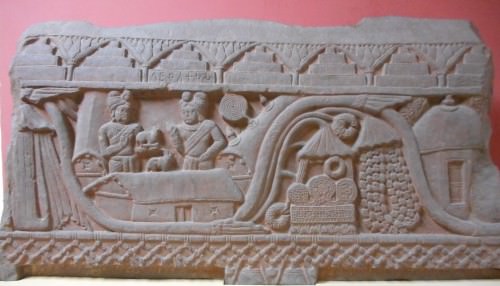
Sasa Jataka Narrative Sculpture
RELIGION
Chandragupta, the founder of the Maurya dynasty, was a Hindu. In later life, he became a Jain. His grandson Ashoka put the state's entire resources to promote Buddhism, but whether he formally converted to the faith remains unclear. The populace, by and large, belonged to one of these three religions while other noticeable groups were atheists, agnostics, or those who subscribed to primitive faiths.
DOWNFALL
About 50 years after Ashoka's death, the Mauryan king was killed by his general-in-chief, Pushyamitra, who founded the Shunga dynasty. Scholars give several reasons for the empire's downfall, the major ones being its size and its weak rulers after Ashoka. Border states had started asserting their independence right after Ashoka's death. The empire started shrinking under Ashoka's successors. By the time Pushyamitra seized the throne, the mighty Mauryan Empire was a fraction of its size, reduced to only the three city -states of Pataliputra, Ayodhya, and Vidisha, and some parts of the Punjab.
Bhagavad Gita › Antique Origins
Definition and Origins
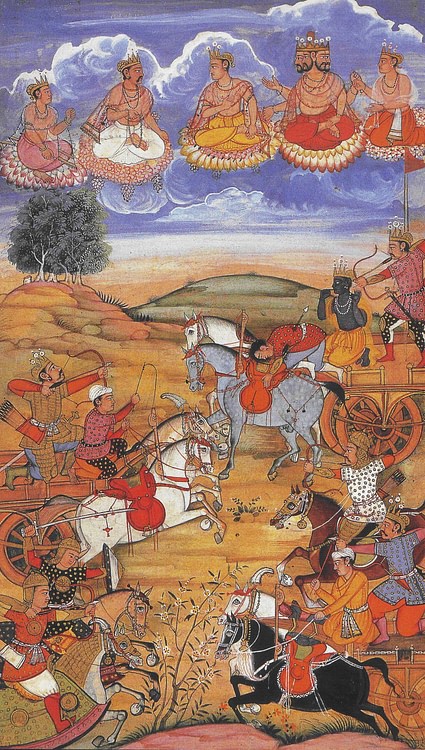
The Bhagavad Gita is an ancient Indian text that became an important work of Hindu tradition in terms of both literature and philosophy. The earliest translations of this work from Sanskrit into English were made around 1795 CE by Sir Charles Wilkins. The name Bhagavad Gita means “the song of the Lord”. It is composed as a poem and it contains many key topics related to the Indian intellectual and spiritual tradition. Although it is normally edited as an independent text, the Bhagavad Gitabecame a section of a massive Indian epic named “The Mahabharata ”, the longest Indian epic. There is a part in the middle of this long text, consisting of 18 brief chapters and about 700 verses: this is the section known as the Bhagavad Gita. It is also referred to as the Gita, for short.
AUTHORSHIP & ORIGIN
The Bhagavad Gita was written at some point between 400 BCE and 200 CE. Like the Vedas and the Upanishads, the authorship of the Bhagavad Gita is unclear. However, the credit for this text is traditionally given to a man named Vyasa, who is more of a legend than an actual historical figure; because of this, Vyasa has been compared to Homer, the great figure of ancient Greek epic poetry.
It has been suggested that the Bhagavad Gita was originally an independent text as, except for the first chapter, the Bhagavad Gita does not develop the action of the Mahabharata. Furthermore, the Bhagavad Gita is at odds with the general style and content of the Mahabharata. Once the Gita is over, the narration of the Mahabharata resumes.
The Gita was written during a time of important social change in India, with kingdoms getting larger, increasing urbanization, more trade activity, and social conflict similar to what was happening when Jainism and Buddhism developed. This ancient Indian text is about the search for serenity, calmness, and permanence in a world of rapid change and how to integrate spiritual values into ordinary life.
THEME, PLOT, & SETTING
Around the time when the Gita was written, asceticism was seen in India as the ideal spiritual life. Ascetics from different sects along with Jains and Buddhists all agreed that leaving everything behind (family, possessions, occupations, etc.) was the best way to live in a meaningful way.
YOU WERE NEVER BORN; YOU WILL NEVER DIE. YOU HAVE NEVER CHANGED; YOU CAN NEVER CHANGE.BHAGAVAD GITA
The Bhagavad Gita revolves around the following questions: How can someone live a life spiritually meaningful without withdrawing from society? What can someone who does not want to give up family and social obligations do to live the right way? The Gita challenges the general consensus that only ascetics and monks can live a perfect spiritual life through renunciation and emphasises the value of an active spiritual life.
The plot of the Gita is based on two sets of cousins competing for the throne: The Pandavas and the Kauravas. Diplomacy has failed, so these two clans' armies meet on a battlefield in order to settle the conflict and decide which side will gain the throne. This is a major battle and it takes place in Kurukshetra, “the field of the Kurus”, in the modern state of Haryana in India.
Arjuna, the great archer and leader of the Pandavas, is a member of the Kshatriyas caste (the warrior rulers caste). He looks out towards his opponents and recognizes friends, relatives, former teachers, and finally reasons that controlling the kingdom is not worth the blood of all his loved ones. Emotionally overwhelmed, Arjuna drops down, casting aside his bow and arrows and decides to quit. He prefers to withdraw from battle; he prefers inaction instead of being responsible for the death of the people he loves.
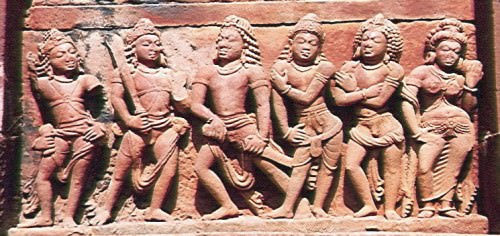
Pandavas
His chariot driver is the god Vishnu, who has taken the form of Krishna. Krishna sees Arjuna quitting and begins to persuade Arjuna that he should stick to his duty as a warrior and engage the enemy. The Bhagavad Gita is presented as a conversation between Arjuna and Krishna, a man and a god, a seeker and a knower.
THE MESSAGE OF THE BHAGAVAD GITA
Arjuna is worried about entering the battle and destroying his own family, so Krishna begins by explaining five reasons why Arjuna should not be troubled by this. Essentially Krishna shows Arjuna why he will not get bad karma from taking part in the war.
The first reason Krishna mentions is that because atman (the self) is eternal, it is a mistake to think that one can actually kill someone. What actually happens is that people are sent to the next stage of reincarnation.
[Krishna speaking] One believes he is the slayer, another believes he is the slain. Both are ignorant; there is neither slayer nor slain. You were never born; you will never die. You have never changed; you can never change. Unborn, eternal, immutable, immemorial, you do not die when the body dies. ( Bhagavad Gita 2:19-20)
Another reason why Arjuna should fight is because of honour and duty, also referred to as dharma or cast duty. Arjuna is a member of the warrior class; the battle is the very reason of his existence. It is not sinful to fulfil your duty in life.
The third reason Krishna gives is that inaction is impossible. Withdrawing from battle is in itself a conscious decision; not choosing is still a choice. This is in a way a criticism of some world-views, such as asceticism, which claim that leaving everything behind is inaction: Withdrawing from society is always a deliberate act.
Another reason given by Krishna is that the source of evil is not in actions, but in passion and desires, the intentions behind the actions. This brings the dialogue to the last reason.
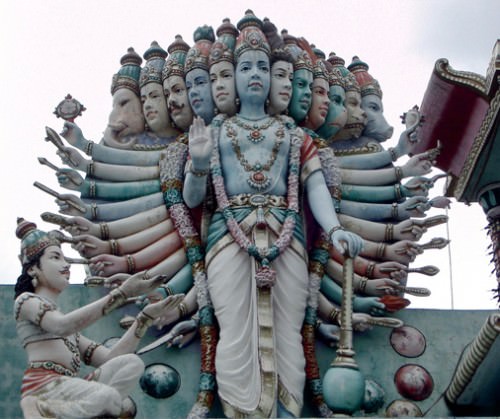
Krishna manifesting his full glory to Arjuna
The fifth and last reason is that there are ways to act where we can do what we have to do without getting bad karma. In the Bhagavad Gita, Krishna explains three ways.
The first way is Jnana yoga (the way of knowledge). This idea is based on the Upanishads and holds that life and death are not real. Selfhood is nothing but an illusion. All we see are manifestations of the oneness. Once we realize that the oneness is behind all things, we can escape the bad karma from acting.
[Krishna speaking] I am ever present to those who have realized me in every creature. Seeing all life as my manifestation, they are never separated from me. ( Bhagavad Gita 6:30)
The second way is Bhakti yoga (the way of devotion). This in an idea developed in great detail in Hinduism and holds that our actions can be dedicated to Krishna by surrendering our will to him, and he will take upon himself any bad karma.
The third way is Karma yoga (“the way of action” or “the way of works”). The idea behind Karma yoga is acting without attachment; in other words, to act without being so concerned about the outcome of our actions. According to this view, if we act in such a way as not to get attached to the fruits of our actions, we can be more effective. Sometimes emotions like fear, embarrassment, or anxiety can interfere in the outcome of what we do.
[Krishna speaking] Neither agitated by grief nor hankering after pleasure, they live free from lust and fear and anger. Established in meditation, they are truly wise. Fettered no more by selfish attachments, they are neither elated by good fortune nor depressed by bad. Such are the seers." ( Bhagavad Gita 2:56-57)[Krishna speaking] Thinking of objects, attachment to them is formed in a man. From attachment longing, and from longing anger grows. From anger comes delusion, and from delusion loss of memory. From loss of memory comes the ruin of understanding, and from the ruin of understanding he perishes. ( Bhagavad Gita 2:62-63)
Each of these three ways to act without getting bad karma is suitable for different people or castes. Priests would follow the way of knowledge; peasants, merchants and commoners might be inclined to the way of devotion; warriors would identify themselves with the way of action. Finally, Arjuna decides to obey Krishna by engaging in the battle and in the end the Pandavas regain control of the kingdom.
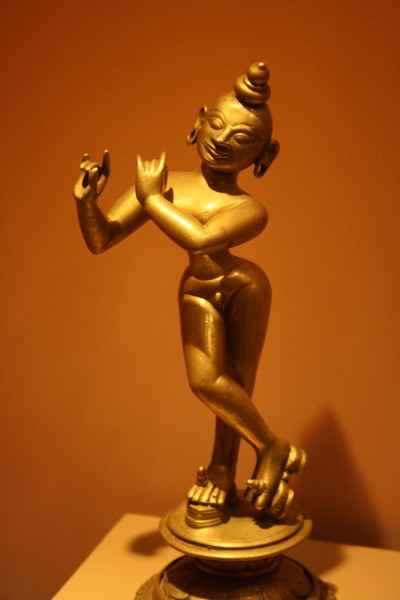
Krishna
THE INFLUENCE OF THE BHAGAVAD GITA
No other Indian text has attracted more attention from foreigners than the Bhagavad Gita. Important figures such as Mahatma Gandhi held the Gita as their main reference book.
The physicist Robert Oppenheimer watched the massive explosion and blinding flash of the mushroom cloud of the first atomic bomb test in New Mexico. Oppenheimer then claimed that when he saw that, two verses from the Gita came to his mind:
If a thousand suns were to raise in the heavens at the same time, the blaze of their light would resemble the splendor of that supreme spirit. ( Bhagavad Gita 11:12)
I am time, the destroyer of all; I have come to consume the world [...]. ( Bhagavad Gita 11:32)
This ancient book which contains a message that could be considered either distressing or inspiring still addresses some of the concerns we have today, and its message has spread all over Asia and across the globe.
LICENSE:
Article based on information obtained from these sources:with permission from the Website Ancient History Encyclopedia
Content is available under License Creative Commons: Attribution-NonCommercial-ShareAlike 3.0 Unported. CC-BY-NC-SA License